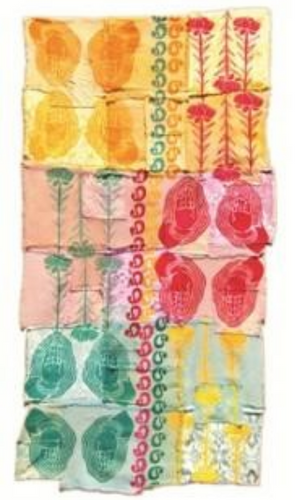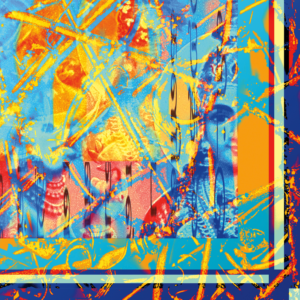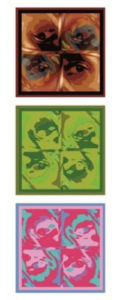Student Aharani’s Life and Creative Talent
Student Aharani’s Life and Creative Talent
Aharani Sivaplan had SMA Type 2 and was planning her next art exhibition when she died on 29th September 2009 at the age of 32 years. Here, Karen Johnson, Curriculum Head for Creative Studies and Media, Hereward College Coventry, describes Aharani’s inspiring life’s work.
This article first appeared in the Autumn 2011 edition of our Inspirations magazine (now SMA Matters).

Aharani Sivapalan was an amazing individual who led a remarkable life and was determined to achieve everything she put her mind to in the short life that she lived. Diagnosed at an early age with Spinal Muscular Atrophy Type 2, Aharani was driven throughout her life by an extraordinary desire to make her art work and she was also a very strong-minded individual, who made sure she got the arts education that would equip her ultimately for the career she went onto achieve.
As a British-Tamil artist she was first guided by her parents into exploring the beauty of natural objects through observing them and drawing them, she also revealed her creative talents when drawing many members of her own family. She quickly demonstrated that she was a budding artist even at this early stage of her life, leading ultimately to a remarkable career as a textile artist, spanning over three decades.
The family encouraged Aharani to continue drawing and discussed what Aharani could do for herself as well as perhaps gain employment or become self-employed in the future.
A lot of her time was taken up with her mum massaging her and giving her physiotherapy and attending to her disability. However, when she was free she was encouraged to focus on her artwork, this meant that she was also moving and using her fingers to exercise her joints and muscles in a therapeutic way.
 She won a competition for her design work in 1985 when she produced a Christmas card design entry for The Jennifer Trust (now SMA UK) and she went onto inspire many people through her determined approach to life.
She won a competition for her design work in 1985 when she produced a Christmas card design entry for The Jennifer Trust (now SMA UK) and she went onto inspire many people through her determined approach to life.
The doctors had told Aharani’s family at a very early age that she would never walk and that she would be in a wheelchair all her life. They also said that she may not even reach her teenage years and that her life expectancy was very short.
‘I think that was when I had made my mind up before she realised it that I was going to push her towards art.’ (Dad)
In the early 80’s Aharani’s father went back to Sri Lanka to start his own business. The family followed and they lived there for 2 years. I think she first started to bring her cultural heritage into her work during this trip, which exposed her to Tamil culture and made the link between her British upbringing and her Tamil identity.However there were racial problems at that time and the family business could not continue, so they returned to England.
On the family’s return Aharani attended Ashfield School in Leicester where the family settled. Her parents were keen to support her creativity and made sure she had professional help early on. In terms of her creativity she went into another dimension when she was introduced to her first art teacher Irene Hutchinson. She would visit Aharani at home to give her art lessons.
‘I was very keen on collage, so I thought I would do some collage with her, however because of her limited movement she couldn’t tear the paper. This led me onto getting her started with painting instead.’ (Irene Hutchinson)
 It became increasingly clear to Aharani’s family that she had ambitions to pursue her creativity and was very determined to do so.
It became increasingly clear to Aharani’s family that she had ambitions to pursue her creativity and was very determined to do so.
Aharani arrived at Hereward College in Coventry in September 1995. She started studying a computer art and design course learning how to use Photoshop and Illustrator. She was really excited about being able to use the computers to create her art work, especially as the motor skills in her fingers had decreased in movement and using pencils and brushes was getting more difficult for her at this time. She was also able to use assistive technology to access her work by using a touch pad rather than a mouse or keyboard.
Whilst at Hereward College Aharani started to develop her interest in fashion and textiles.
‘She loved fashion and shopping; she was always interested in buying clothes and this is how I think her interest in fashion and textiles started to influence her art work.’ (Mum)
Having completed her foundation studies course, Aharani started to think about what the next stage in her development might be. So she started talking to her family about the prospects of going onto University.
 Aharani’s determination won through and she started to consider Bretton Hall University in Wakefield as her next step. Hereward College had a partnership with this University at that time. The University had an excellent course there in Textiles (surface pattern), which was an ideal course for her to study. However there was no access to the textile studios on the first floor. The University were in the course of moving to new accommodation that would be fully accessible.
Aharani’s determination won through and she started to consider Bretton Hall University in Wakefield as her next step. Hereward College had a partnership with this University at that time. The University had an excellent course there in Textiles (surface pattern), which was an ideal course for her to study. However there was no access to the textile studios on the first floor. The University were in the course of moving to new accommodation that would be fully accessible.
She started her degree course at Hereward College in 1999, with many visits to the university. However she struggled in her motivation throughout these two years because she really wanted to be with her peers in Leeds.
‘My whole year has been spent trying to organise my transfer of living and studying at Bretton Hall. My motivation to work has suffered a lot.’
Eventually she arrived at Leeds University and she started her third year on 1st October 2001. She progressed, against the odds, from special school to university where she was able to explore her ethnicity in a Westernised context and to make allusions to disability that were subtly contained within her textile designs.
There is a further dimension to Aharani’s achievements in that she was a disabled young woman pioneering a route into higher education at a time when few did. She found a way to express her self-identity positively against an historical background of negative stereotypes.
‘East meets West’ was a theme that preoccupied Aharani’s work at this time and reoccurred throughout her creative development. It provided her with the vehicle not only to explore her design skills, but also her ethnicity in a Westernised context, and her identity as a disabled young woman and, in so doing, to resist the stereotypes and limited expectations that society held around these identifiers.
‘I need to somehow connect the world of colour and fashion with my ideas about the fusion of Eastern and Western fashion. I’m keen to look at the influence of Asian culture on western culture and I will look at the cultural diversity and clash of cultures.’ (Aharani)
Now that Aharani had achieved her ambition to achieve a BA Hons in Textiles (surface pattern) from Leeds University, she was quickly planning the next stage of this very rich and creative journey. She was very keen to gain employment in a field that harnessed all her creative talents and make the move from home into independent living.
‘To support herself she was determined to find work, she wasn’t the sort of person who would sit around. She said "I can’t just sit at home, I want to go out and work, that’s what makes me tick." (Mum/Aharani)
She gained a teaching qualification and became a member of staff at Hereward College in 2002 in the Creative Studies and Media department working as a part time lecturer in textiles. She was highly respected both by staff and students and she was a fantastic role model to many of the students that she taught at the college. She also went on to develop her textile design work and had many exhibitions of her art work throughout her career as a textile artist.
